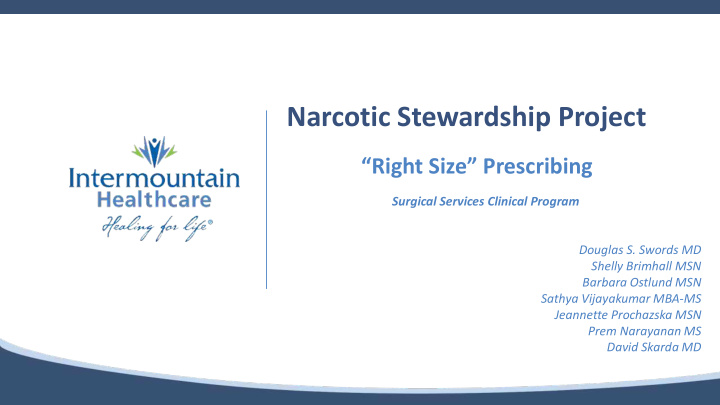



Narcotic Stewardship Project “Right Size” Prescribing Surgical Services Clinical Program Douglas S. Swords MD Shelly Brimhall MSN Barbara Ostlund MSN Sathya Vijayakumar MBA-MS Jeannette Prochazska MSN Prem Narayanan MS David Skarda MD
Prescription Misuse is a Serious Problem • Opioid overdose now the leading cause of injury related deaths in the United States (surpassing MVA’s) • Opioid overdose deaths quadrupled in the last 15 years • 55% of opioid users received pills for free from a family member or friend who had excess pills • Persistent opioid use after surgery - 6%
Surgeons: Gatekeepers to Prescription Opioids Annals of Surgery April, 2017 Issue.
Surgeons • Swinging pendulum • Law of unintended consequences • No refills • No call-in prescriptions • Patient satisfaction scores • Overprescribe • Want to control pain • Trust patients • Don’t want to be called for more at 10:00 pm • Difficult to give second prescriptions • HCAHPS scores matter • Mix narcotic naïve and narcotic exposed patients “We might prescribe fewer if we knew how many patients take.”
Challenge Accepted
How Intermountain is addressing Utah’s opioid epidemic: “It’s time for courage and leadership on our part…” Opioid Summit Opioid Community Collaborative • Medication disposal drop boxes • Naloxone rescue kits • Increased caregiver training Surgical Services Clinical Program Pain Services Clinical Service • Narcotic Initiative – Surgical Patient Pain Med Survey • New prescribing recommendations - • “Right Size” opioid prescribing recommendations - by 40% reduction procedure/procedure type (based on data collected) • Increased education – alternative pain management strategies
Current Process: Rolled out to all Intermountain facilities on iCentra • Began Jan. 9, 2017 • Patient provides email address • 2 weeks postop – survey sent out • Exclusions for now • C-Sections (L&D), Endoscopy & CT Patients • Averaging 31% survey response rate
Education… How do we let patients know they will receive a survey? • Address in Preop (PAT) phone call (scripting provided) • Address in Post-op (discharge) phone call (scripting provided) • Provide patients with a rack-card • Rack-cards in OR waiting area for family members • Inpatients – Included on MAWDS discharge teaching sheet & can also print info with discharge teaching sheets
iCentra additions Scripting dialog initiated March 9, 2017 SDS/PACU – Scripting about the Narcotic Survey now displays on the Preadmission Assessment and the Postop/Procedure phone call pages. The nurse making the phone call uses this verbiage to inform patients that they will receive a survey about their narcotic usage after surgery.
Rack-Card
Intermountain Pain Medication Patient Survey Example
2017 Goal: Increase opioid stewardship, reduce excess opioids in the community, and decrease opioid misuse/abuse. Method: Use patient-reported feedback to discover the quantity of opioids used by patients and their opioid-naïve status. Cross-reference patient-reported data with enterprise data warehouse opioids prescribed and surgical records to discover use and procedure comparisons. Propose ideal opioid prescription quantities (ranges by procedure/procedure types) As of Wednesday, November 29, 2017: We sent 36,415 initial surveys Patients completed 11,113 surveys Average Initial survey response rate of 30.52%
Survey responses – Duration of Opioid Use Prior to Surgery?
Do you feel your pain was well controlled?
Survey Responses – Was Your Pain Well Controlled? Pain Control Responses Pain Control Response Opioid Naïve Opioid Exposed Strongly Agree 77.50% 22.50% Agree 71.29% 28.71% Neutral 69.12% 30.88% Disagree 54.55% 45.45% Strongly Disagree 40.00% 60.00%
What have you done with leftover tablets (or liquid) of your opioid pain medication?
Did you receive instructions after your surgery or from the pharmacy regarding how to properly dispose of any unused opioid pain medication ?
http://useonlyasdirected.org/ Intermountain drop boxes yield over 6,400 lbs. unused meds as of August 17, 2016
For your safety and the safety of your family and the community, we recommend that you Take any remaining pain medication to a safe disposal drop box located at Intermountain Community Pharmacy locations or other sites across the region. Use the Safe Disposal: Drop-off Locator to find a drop-off location near you: http://useonlyasdirected.org/throw-out/
Clinician Education Has Started: • Mid November sent out first dosing recommendation letters to: • Gen Surg • ENT • Gyn • Urology • Addition of Obstetric (C-sections & Vag-deliveries) population to the Patient Pain Medication Survey
Urology
GYN
ENT
Surgeon Messaging Now • “Right Size” Prescribing • Know how many doses patients use after the operation • Know if you patient has been taking narcotics before your operation • DOPL CSD • Consider Naloxone for patients who have been taking narcotics before the operation and may have a respiratory/pain tolerance development differential
Surgeon Messaging Future • “Right Size” Prescribing • Prescribe the 2x the mean consumed with a partial fill of 1x the mean consumed • Tailor opioid prescriptions to patient’s genetic phenotype • Further pain medication prescriptions should be from the PCP
Success
Consequences Intended: Unintended: • • Decrease deaths Increase the value of prescription narcotics • Decrease the development of • Supply/demand new addiction • • Drive current misusers to Decrease cost alternatives • Injection • Impurities
Acknowledgement/Credit Jay Bishoff
Questions
Recommend
More recommend